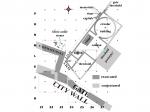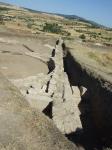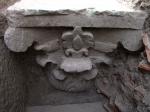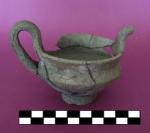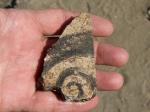Summary (English)
The idea that the two massive walls uncovered in 2011 belong to a stoa was negated by the angle of their intersection which is 105°. The wall L24.53 originates at the western gate of the city wall, then joins with L23.52 at the 105° angle, which continue off in a southeasterly direction. A gate was discovered in L23.52 in the easternmost trench, but unfortunately it was not completely uncovered this season. There is a complex of small rooms abutting walls L24.53 and L23.52 in the 105° angle. Most of the stones of these walls have been robbed away by people who used the ruins of Bylazora as a quarry, after the city had been destroyed in the second century BC. On the hard plaster and terracotta floors of these rooms a great mass of food storage, serving, and cooking vessels were found, as well as a large terracotta hearth. The building was destroyed by fire at some point. Specimens of some of the large charred roof timbers were taken for analysis. Numerous painted plaster fragments indicate that the walls of the facility were decorated. The pottery found “inside” the complex dates from the late third and early second centuries BC.
Remains of what appears to be a ramp built up against the wall L23.52 were discovered southeast of the above mentioned complex. The stone robbing was so thorough here that it is difficult to ascertain whether the ramp was built earlier than the L23.52 wall or it is associated with it. A fallen Doric column and a capital were found to the southwest of the ramp. The column may have been one of several that stood upon a threshold of large, finely cut stones.
One of the most exciting structures found this season is a circular building bounded in by a square building – both built up against the wall L23.52. The complete circle and square have not been exposed yet. In the western part of the circle-square complex there is a break in the walls that might have been the entrance but it is unclear since the stones were robbed away. A square stone was found in the middle of the circular building, whose purpose is unknown at this time. The purpose of the circular building remains unknown since the floor has not been reached, nor the building is exposed to its full extent.
A small raised dedication platform was discovered outside the walls L24.53 an L23.52, in square P27 (just alongside the threshold of the gate in the wall L23.52). It consists of four steps upon which at least two small altars and at least two dedicatory Corinthian capitals were placed. It is very interesting that the Corinthian capitals belong to a period of the early second century BC which makes them one of the earliest samples of the type discovered in this part of the Mediterranean.
Director
- William Neidinger - Texas Foundation for Archaeological and Historical Research
Team
- Stefan Danev - Museum of Sveti Nikole
- Eulah Matthews - Texas Foundation for Archaeological and Historical Research
Research Body
- Museum of Sveti Nikole
- Texas Foundation of Archaeological and Historical Research





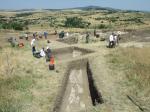
![Download [PDF]](/excavation/skins/fasti/images/results/download_sml.png)
